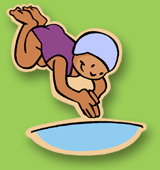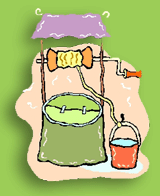Groundwater


|
Beneath you, there is something so important that you probably wouldn't live where you live without it. You can't see it, and you may not know it is there. It is groundwater. People living in the Regional District of Nanaimo use groundwater for drinking, irrigating and fire protection. Groundwater is precipitation (rain, snow or sleet) that seeps into the soil below us. It moves downward (because of gravity) and fills up the spaces between particles of rock, gravel, sand, and soil. If you're at the beach and you dig a hole in the sand near the water it doesn't take long before you hit soggy sand does it? This water is groundwater. The water in the lake that you see, and can jump into to cool down, is called surface water. Some areas underground can hold a lot of water. This is because some types of rock can hold more water. For example, they may have a lot of holes, or be very soft and soak up water like a sponge. Sometimes it is easy to bring this water to the surface through a pipe called a well. The pipe, or well, is drilled into the rocks. Groundwater is then pumped through the well and into pipes that eventually end up at our houses. There are many wells beneath our houses pumping water for people in the Regional District of Nanaimo. These areas underground that hold a lot of water, and can be pumped with a well are called aquifers. Sometimes, aquifers can have flowing streams or even caves filled with water. Water Conservation Groundwater and surface water can trade places. Groundwater can move through the ground into the ocean, or a lake, or stream. Surface water, like in a lake, can soak down into the ground and become groundwater. The water in our aquifers isn’t always at the same level. It rises and falls, depending on how much it has rained, or how much we are pumping. What do you think might happen if there isn’t much rain, like in the summer? What do you think might happen if people are using a lot of water? If you guessed that the aquifer might run dry, you’re right. If the water level drops below the well, water can no longer be pumped into our homes. This happens if water is used up faster than it is ‘recharged’ (remember infiltration in the water cycle). When this happens, there is a water shortage. This means there isn’t enough water for people to do the things they usually do. During a water shortage people often must stop watering lawns and gardens, or filling up swimming pools. To prevent a water shortage we must all conserve water. Conserving water means protecting it, making sure there is enough for everyone's use. Click here and learn how you can conserve the RDN's water resource. Contamination and Pollution It's possible that anything seeping or leaking into the ground can cause groundwater to become polluted. This is why everyone must be careful about what they put on their lawns, the ground, and down their sinks and toilets. |
